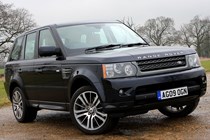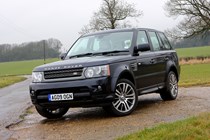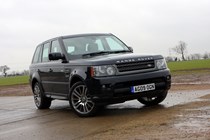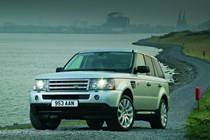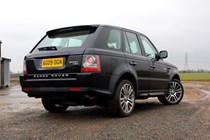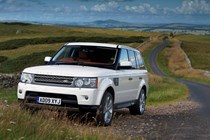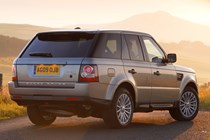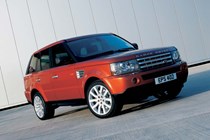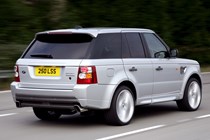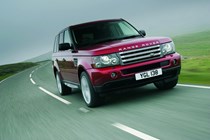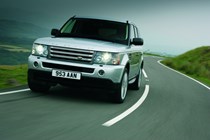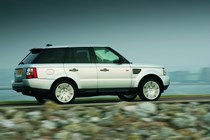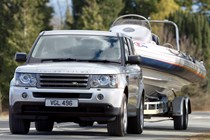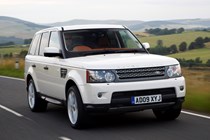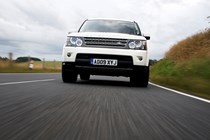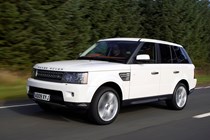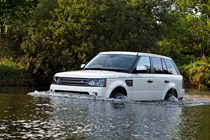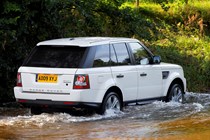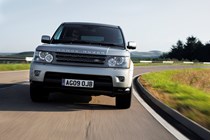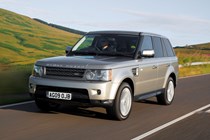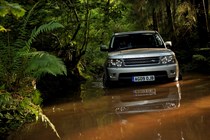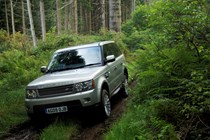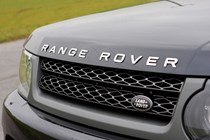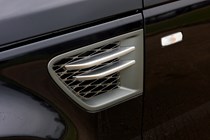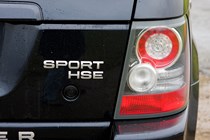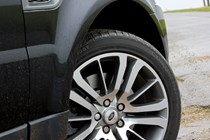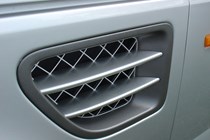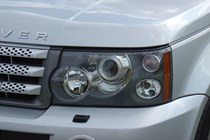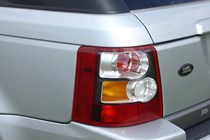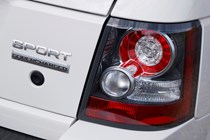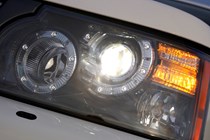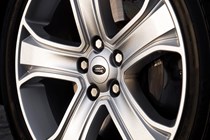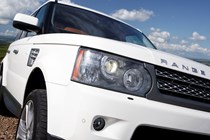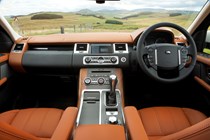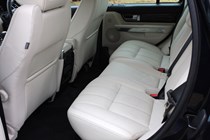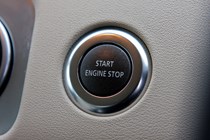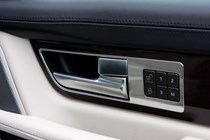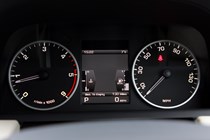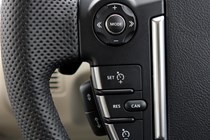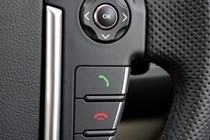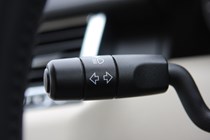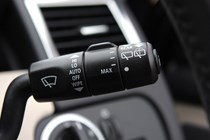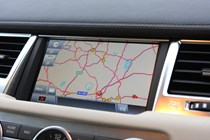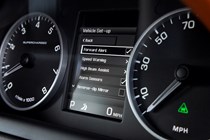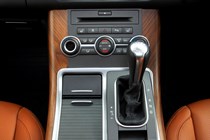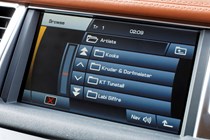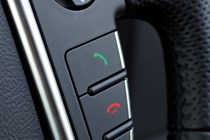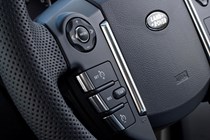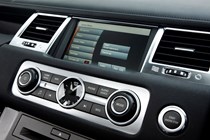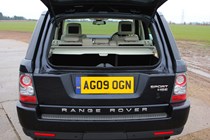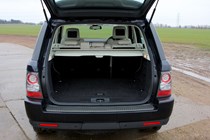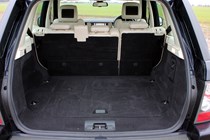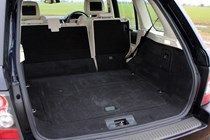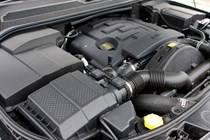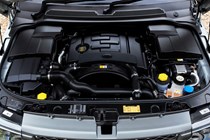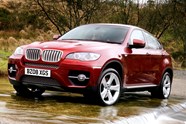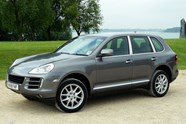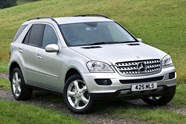
Range Rover Sport Estate review
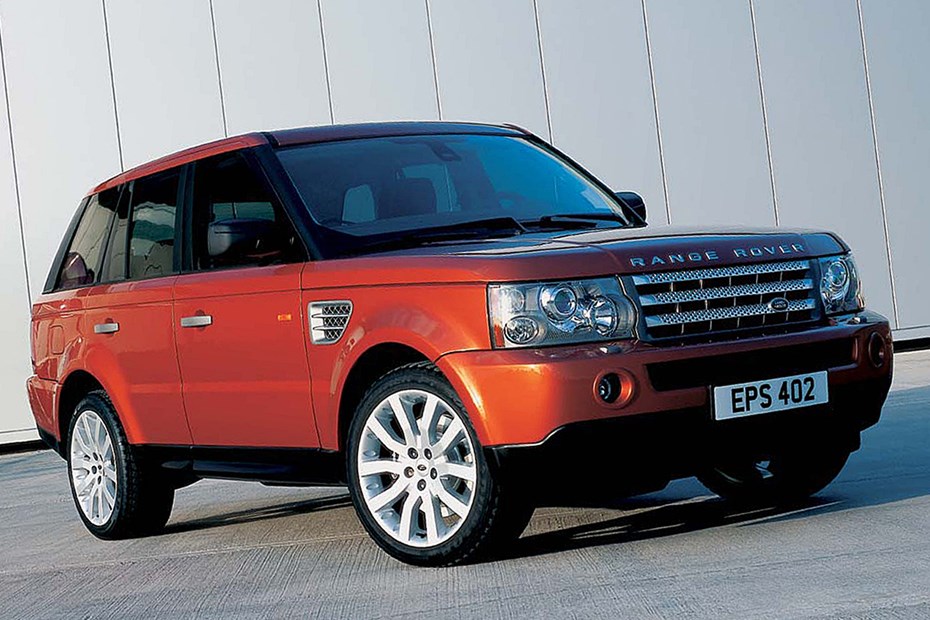
At a glance
| Price new | £37,845 - £75,265 |
|---|---|
| Used prices | £1,093 - £13,313 |
| Road tax cost | £415 - £735 |
| Insurance group | 38 - 49 |
Get an insurance quote with

|
|
| Fuel economy | Not tested to latest standards |
| Range | 329 - 517 miles |
| View full specs for a specific version | |
Available fuel types
Petrol
Diesel
Pros & cons
- Chunky styling,
- Wonderfully comfortable
- Handles well for a 4x4 yet capable off-road
- High running costs
- Fatally flawed V6 diesel
- Automatic gearbox can be a little sluggish to change down
Land Rover Range Rover Sport (05-13) rivals
Overview
Introduced in 2005, Land Rover‘s first generation Range Rover Sport (L320) appears to be a smaller and more athletic version of the larger, more traditional third generation Range Rover (L322). It was the first Range Rover primarily designed to be driven on-road, and it includes a lot of advanced technology to achieve handling that justifies the ‘Sport’ name.
Choose the most powerful 5.0-litre supercharged version and it’s remarkable, yet as a Land Rover, the Sport also offers serious off-road capability. As a used buy its popularity is largely driven by street cred, rather than green lane credibility, and that’s partly down to the blend of technology that Land Rover chose to put into the Range Rover Sport.
Although it is a newer model than the contemporary Range Rover, it owes more to the Discovery 3 – including retaining an old-school ladder chassis despite having full independent suspension. Its rivals include the Porsche Cayenne and Mercedes ML, and as a used buy it has a lot going for it over both of those cars.
If you don’t plan on serious off-roading and are considering the Range Rover Sport as a family SUV, bear in mind that it is an astonishingly heavy car for a five seater. It is also one that cost a substantial amount new, and maintaining that technology does not come cheap.
When browsing used cars for sale the Range Rover Sport looks like good value – and it can be. Find a good one and you’ll enjoy mid-2000s luxury for less than the deposit on a new hatchback. Find a bad one and your repair bills could probably have bought that new hatchback outright. Here’s our guide to buying the 2005-2013 first generation Range Rover Sport.
Range Rover Sport (L320) known faults and common problems
Fans of Land Rover products can manage their expectations, but if you haven’t owned a Land Rover, Range Rover or Jaguar before bear in mind that the advanced technology and engineering is not something to take for granted and ignore. The Range Rover Sport achieved glowing reviews when launched, mostly for the way it took almost two and a half tonnes of 4×4 and made it handle like a hot hatch without compromising off road ability.
It’s packed with sophisticated systems, such as Terrain Response – a system that optimises the car’s off-road performance depending on the road surface. Active anti-roll, powerful, complex engines, advanced electronics all work brilliantly when new but there’s a lot to go wrong, and by the time the car is over a decade old, a lot of it will. It’s also a popular workhorse for heavy towing, which can mean more wear on suspension, drivetrain and brakes.
Interior trim and bodywork is generally robust, but underneath it inherits some more old-school issues from its Discovery ancestry and the popular TDV6 engine is a significant weak spot. 2009-on Range Rover Sports benefit from a thorough facelift that brought a much upgraded interior, improved engines and a wider range of options.
Ciry-dwellers, we have bad news – none of the diesel Range Rover Sports of this generation are ULEZ or clean air zone compliant. Euro 6 standards were met in the second generation L494.
2005 – 2013 Range Rover Sport buying guide
Common issues, and what to look for if you’re looking at getting one
1. Take an overall view first – the Range Rover Sport’s mass market appeal means varied owners
We all know the stereotype from the Range Rover Sport launch; it’s as if BO55 numberplates were a factory option. As a used buy the Range Rover Sport was highly aspirational for buyers who might not have chosen a 4×4 or performance vehicle before, and thus weren’t prepared for the maintenance and running costs. That desirability means middle-aged examples ended up as profitable trade stock away from specialist dealers, and the image-first appeal resulted in a lot of cars getting third-party oversized wheels, modified lights and ‘bling’.
If that’s why you want one, don’t be tricked into paying over the odds for cheap mods. Look for well-known brands and receipts for any upgrades. If you want an unmolested one, look carefully for tell-tale trim, panel and chassis damage from past mods being removed. Above all, don’t try and convince yourself that one obvious issue like filthy, baggy seats or budget tyres on massive wheels can be rectified to make the whole thing perfect. If one part of the car has been neglected, you know the rest will follow suit.
While we look at some issues you can find with your own senses, a diagnostic tool that can read all the ECUs on the car is essential. Not all aftermarket ones can provide full data, so for any significant investment find a specialist with the right system and pay for an inspection. It could save thousands and prevent you buying someone else’s problems.
2. Diesel engines: V6 with six-speed automatic – knocking on heaven’s door
Assessing a diesel engine in a used car is always difficult because the typical points of ‘listening for odd noises’ are drowned out by the entirely normal noises of compression-ignition. However, a TDV6 or TDV8 in good health is a reasonably refined engine. Make sure your test drive includes some acceleration uphill, with the windows down, and listen for a smooth beat and consistent pitch as revs rise. There’s no need to be aggressive – just make sure the car is working hard under load.
This will reveal two potential problems. First, on high mileage cars smoke from failing turbochargers (with the 3.0-liitre version you may never see a problem from a failed secondary turbocharger unless you use higher revs). Second, the dreaded ‘knock’ that on the TV6 is all too often a broken crankshaft. Even if the vehicle seems to be driving well on light tasks, the minute it’s asked to work hard the fact that half the engine is merely going through the motions will be very apparent.
While the V6 diesel failure is down to a weak point exacerbated by vibration from the six-speed transmission, it can be mitigated by frequent (correct) gearbox maintenance, replacement of the harmonic balancer when the cam belt is replaced, and generally sympathetic treatment and maintenance such as getting misfires attended to promptly. Other problems affecting the diesel engines, such as slipped bearings and failing emissions tests, are generally alleviated by ignoring the consumer-friendly extended service intervals and changing the oil at or below 10,000 miles, and only using high-quality oils and filters.
Replacement of a failed turbocharger necessitates lifting the body off the chassis. While the car is designed for that to take less than two hours, after 18 years on (and off) the road, you know it won’t go by the book.
3. Diesel engines: V6 with eight-speed gearbox and TDV8 models – the ones to have
Later Range Rover Sport SDV6 models with eight-speed gearboxes are less prone to the crank failure issue, though they still need more frequent maintenance than Land Rover specified to last a long time. The V8 diesel is offered in 3.6-litre and 4.4-litre versions, and the later the model you get the better it is likely to be.
These are complex engines compared with the simple diesels found in older Land Rovers, but the weaknesses are typical of modern technology and include EGR system failures, leaking injectors, failed sensors and rattling/worn timing chains and guides on the TDV8 (the V6 uses a timing belt). Many of these issues can be avoided by increasing the frequency of oil changes and making sure the cooling system and ancillaries (such as oil pumps on early V6s) are replaced rather than neglected.
4. Petrol engines: AJV8 4.4-litre, 4.2-litre and 5.0-litre supercharged
Most buyers lean towards the diesel because a claimed average 32mpg is reasonable to live with, where the definitive Range Rover Sport with over 500hp of 5.0-litre supercharged punch is more likely to deliver around 15mpg. For London-dwelling fans of the RRS the petrol model is the only way to avoid ULEZ. The best option for long-term reliability is an unmodified 4.4-litre, naturally aspirated Range Rover Sport – if you can find one. This is not the same engine as the 4.4-litre Range Rover L322 which used a BMW unit.
Early 4.2 models can suffer timing chain guide wear, but on the whole the AJV8 is a strong and reliable engine if maintained well. Supercharged models that knock or rattle on a cold start may need a simple repair to part of the supercharger (the coupler), but if rattling continues at speed, or gets worse/becomes like a grinding noise when warmed up then you may need to replace or rebuild the supercharger.
Given the substantial running cost on petrol, you’re likely to find LPG conversions – we would avoid them unless fitted early in the vehicle’s life, fully documented, and a high-end system known to work with the AJV8 engine. Bodged and cheap systems will cause running issues, valve seat wear and often involve damage to bodywork and interior as well.
5. Automatic gearboxes
Range Rover Sports feature a ZF six-speed automatic which is generally robust, but many owners believe is ‘sealed for life’ when ideally it should have the flud changed every 40-60,000 miles depending on usage. Neglected six-speed gearboxes can contribute to failure of the crank on the TDV6. If the car feels like there is obvious vibrantion from the engine or gearbox, particularly when held on the brakes in drive (D), we would only buy if it’s very cheap – then get the gearbox and engine oils and filters changed immediately.
Feel for slurring changes and juddering when moving at slow speeds, and if you can find a downhill area check the hill descent control. Usually the gearbox’s ECU will sense problems before the driver and will put the car in limp home mode.
The eight-speed gearbox on 2011-on SDV6s is better for economy and emissions. It’s also generally very reliable, and a car with a full service history carried out correctly should not have any problems. Cars used for towing extensively may have more wear but if they’ve been maintained properly it shouldn’t put you off an otherwise good example.
Away from the gearbox itself, inspect the ATF cooler pipes, condition of the wiring, and check for spills of sugary drinks into the gear selector.
6. Four wheel drive system and off-road tech
Most of the time you will have to trust the computer to tell you if there is an issue with the Range Rover’s 4×4 system, but there is one easy feature to check – put it in low range, then back to normal. When driving open the windows and listen for whines or drones that vary with road speed, then do the same with the windows up and back seats folded forward. Rumbles and noises can indicate wear in the front or rear differentials.
Most issues with modern Range Rover four wheel drive systems are related to sensors, ECUs and ABS, so if it’s quiet when driving and not showing lots of warning lights there’s a good chance it’s working fine.
7. Suspension – air bags and ECUs
While driving you want to listen for knocks and clonks, which can indicate worn bushes for suspension arms and anti-roll bars. These are wear items and it’s reasonable to expect replacement on higher-mileage cars, but you don’t want to pay too much for the Range Rover if it’s due a few hundred pounds worth of bushes.
Unless someone’s removed it, the Range Rover Sport has air suspension and is very smooth, stable and comfortable at speed. It can feel a little wallowy, but should compose itself in fast bends very quickly.
Park, and adjust the suspension height. Again, the computer does most of the work here, but watch how long and how evenly it adjusts the ground clearance. Air suspension is not particularly expensive to repair but you can spend a lot asking a garage to find out what’s wrong so don’t be taken in by sellers saying ‘it’s just an airbag leak’. There are a lot of cheap things it can ‘just’ be, but they add up.
8. Infotainment and interior gadgets
Compared with the original Range Rover the 21st century models are exceptionally luxurious, and the Sport is almost comparable to a Bentley in the amount of complex trim and expensive material you’ll find. Most problems are down to water ingress or damaged wiring, with the central locking system being prone to dodgy locks and quirks.
Check the heater works at all fan speeds and gets hot for both sides of the vehicle (and if it’s a dealer or expensive car, make sure the air conditioning works properly as well). It’s hard to test the heated windscreen where fitted, but if you do get a chance on a cold morning it’s worth checking how much clears.
Pay attention to any towing equipment fitted, particularly if it’s a later addition.
9. Bodywork
Some good news, the Range Rover Sport is not, as a rule, as prone to serious rust as older models, but the signs are that older and neglected examples can rot, and it’s well hidden. Check behind the sills and rear arches, particularly the rear door aperture and lower edge of the arch, and look around the boot floor and seams for both rust and damp.
We’d suggest researching the original equipment and style of any Range Rover Sport you’re considering buying though, as a lot of them have been fitted with aftermarket wheels, trim, acessories and even full facelift or modified fronts with different grilles, lights and bumpers.
While there are plenty of good reasons to spend £5000 facelifting a cheap old Range Rover Sport, the most obvious one is accident damage and cheaper aftermarket parts. Be diligent and make sure any work done isn’t just to your taste, it’s also to the standard you would want it to be from a luxury SUV.
10. Chassis
Unlike earlier Range Rovers and Land Rover Discovery models, the chassis is less critical to body strength. But it is still critical to the safety and strength of the Range Rover Sport. Fortunately it looks like the chassis on the RRS and Discovery 3 is made and finished to a much higher standard than before, and serious rust has yet to be a problem. Surface rust is to be expected, and given time that can become serious.
We would look carefully at suspension mountings and look at how any accessories such as side steps, aftermarket towing equipment have been fitted, and look for obvious dents, creases or repairs that could indicate previous accident damage.
Once you have bought your Range Rover Sport, a small investment in rustproofing should keep the body and chassis in good shape for years.
What’s the 2005-2013 Range Rover Sport like to own?
Any large SUV is not going to be cheap to run, particularly a Land Rover. The Range Rover Sport is no exception. Most new buyers choose the diesel engine, which offers 32.1mpg economy, but 230g/km CO2 still means a higher VED rate than many used SUVs. The payoff is a vehicle that feels unassailable, looks imposing, and is very refined and luxurious.
But it’s not a vehicle to run on a budget, and the older they get, the more people do. If you’re aiming for a bargain find a cared-for privately owned example and avoid the dealer-trade ins with Davanti tyres and dodgy bodykits.
Over the next few pages, we’ll review each aspect of the Range Rover Sport (L320), taking into account its practicality, comfort, fuel economy and performance. If you’re short on time, you can also skip to our verdict page to see if we recommend the Range Rover Sport as a good used car.



